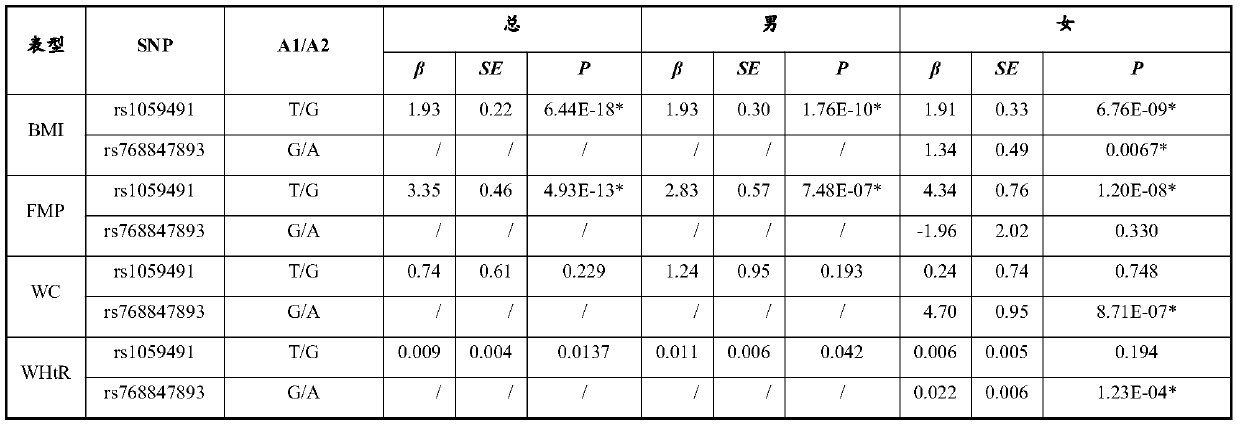Single nucleotide polymorphisms associated with childhood obesity in China and its application
A fat, site-based technology for biomedical applications
- Summary
- Abstract
- Description
- Claims
- Application Information
AI Technical Summary
Problems solved by technology
Method used
Image
Examples
Embodiment 1
[0051] The collection of embodiment 1 sample and the arrangement of sample data
[0052] The inventor collected a large number of blood samples of obese case-control children in primary and secondary schools in Beijing and Tonghua from April 2004 to December 2014. After sorting out the sample data, the inventor selected 6334 samples that met the following criteria for Experimental samples for whole genome exome sequencing and single SNP Sequenom MassARRAY genotyping:
[0053] 1. Obese cases clearly diagnosed by the body mass index (BMI) classification criteria recommended by the International Obesity Working Group (IOTF);
[0054] 2. Han children, aged 6-18;
[0055] 3. The control included normal weight and wasted children, excluding overweight children.
[0056] The demographic data and clinical data of these samples were collected systematically.
Embodiment 2
[0057] Example 2 Peripheral Blood DNA Extraction
[0058] In all the above-mentioned eligible samples, human genomic DNA was extracted using a spin column method (DNA mini-extraction kit, QIAGEN, Germany). The specific steps are:
[0059] 1. Add 20 μL proteinase K to a 1.5 mL centrifuge tube;
[0060] 2. Add 200 μL white blood cell mixture, if the volume is less than 200 μL, make up with phosphate buffer saline (PBS);
[0061]3. Add 200 μL buffer AL (lysate), vortex for 15 seconds, and centrifuge quickly;
[0062] 4. Water bath at 56°C for 10 minutes;
[0063] 5. Centrifuge quickly to avoid leaving solution on the tube cap;
[0064] 6. Add 200 μL absolute ethanol, vortex for 15 seconds, and centrifuge quickly;
[0065] 7. Transfer all the solutions to the QIAamp spin column, centrifuge at 10000rpm for 2 minutes, discard the collection tube, and transfer the spin column to a new collection tube (provided by the kit);
[0066] 8. Add 500 μL buffer AW1 (washing solution 1) ...
Embodiment 3
[0070] Example 3 Whole Exome Detection of SNP in Peripheral Blood DNA
[0071] Whole-genome exome sequencing was performed in the 19 severely obese children and 15 emaciated children who met the above conditions, and the exome sequencing data of the two groups of children were compared to obtain candidate gene loci. The specific steps are:
[0072] 1. DNA quality inspection: Use a UV / visible spectrophotometer (DU800, Beckman, USA) or (NanoDrop 2000, Thermo Fisher, USA) to read the absorbance values at A230nm, A260nm, and A280nm, and calculate the DNA concentration according to the formula (g / L)=A260nm×50, and DNA purity was identified by OD ratio (A260 / A280, A260 / A230). A low A260 / A280 ratio indicates protein residues, but if phenol is used during the operation, it is more likely to be phenol residues, and a high A260 / A280 ratio suggests that ribonucleic acid (RNA) may not be removed completely. A low ratio of A260 / A230 indicates residual salt or small molecular impurity p...
PUM
 Login to View More
Login to View More Abstract
Description
Claims
Application Information
 Login to View More
Login to View More - R&D
- Intellectual Property
- Life Sciences
- Materials
- Tech Scout
- Unparalleled Data Quality
- Higher Quality Content
- 60% Fewer Hallucinations
Browse by: Latest US Patents, China's latest patents, Technical Efficacy Thesaurus, Application Domain, Technology Topic, Popular Technical Reports.
© 2025 PatSnap. All rights reserved.Legal|Privacy policy|Modern Slavery Act Transparency Statement|Sitemap|About US| Contact US: help@patsnap.com



